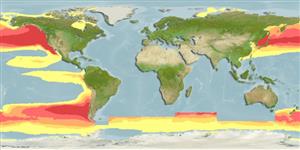Common names from other countries
Environment: milieu / climate zone / depth range / distribution range
Ecología
marino batipelágico; rango de profundidad 37 - 1500 m (Ref. 50610). Deep-water
Western Pacific: Japan. Eastern Pacific: British Columbia, Canada (52°N) to Baja California (27°N), and from Peru (16°S) to Chile (39°S). Also from the southeast Pacific (Ref. 2850).
Tamaño / Peso / Age
Maturity: Lm ? range ? - ? cm
Max length : 33.0 cm TL macho / no sexado; (Ref. 2850)
Short description
Morfología | Morfometría
Espinas dorsales (total): 0; Radios blandos dorsales (total): 16-18; Espinas anales 0; Radios blandos anales: 14 - 16; Vértebra: 50 - 52. Branchiostegal rays: 8.
Mesopelagic at 300-900 m (Ref. 58302). Young migrate in association with Cyclothone signata to within 200 m of the surface at night and feed extensively on small crustaceans (Ref. 4525). Oviparous, with large mesopelagic larvae (Ref. 35760).
Life cycle and mating behavior
Madurez | Reproducción | Puesta | Huevos | Fecundidad | Larva
Eschmeyer, W.N., E.S. Herald and H. Hammann, 1983. A field guide to Pacific coast fishes of North America. Boston (MA, USA): Houghton Mifflin Company. xii+336 p. (Ref. 2850)
IUCN Red List Status (Ref. 130435)
CITES (Ref. 128078)
Not Evaluated
Threat to humans
Harmless
Human uses
Más información
ColaboradoresImágenesStamps, Coins Misc.SonidosCiguateraVelocidadTipo de nataciónSuperficie branquialOtolitosCerebrosVisión
Herramientas
Special reports
Download XML
Fuentes de Internet
Estimates based on models
Preferred temperature (Ref.
115969): 0.5 - 7.9, mean 3.5 (based on 290 cells).
Phylogenetic diversity index (Ref.
82804): PD
50 = 0.6250 [Uniqueness, from 0.5 = low to 2.0 = high].
Bayesian length-weight: a=0.00407 (0.00154 - 0.01080), b=3.17 (2.95 - 3.39), in cm Total Length, based on LWR estimates for this (Sub)family-body shape (Ref.
93245).
Nivel trófico (Ref.
69278): 3.1 ±0.30 se; based on food items.
Resiliencia (Ref.
120179): Medio, población duplicada en un tiempo mínimo de 1.4-4.4 años (Assuming tmax>3).
Fishing Vulnerability (Ref.
59153): Low vulnerability (19 of 100).
